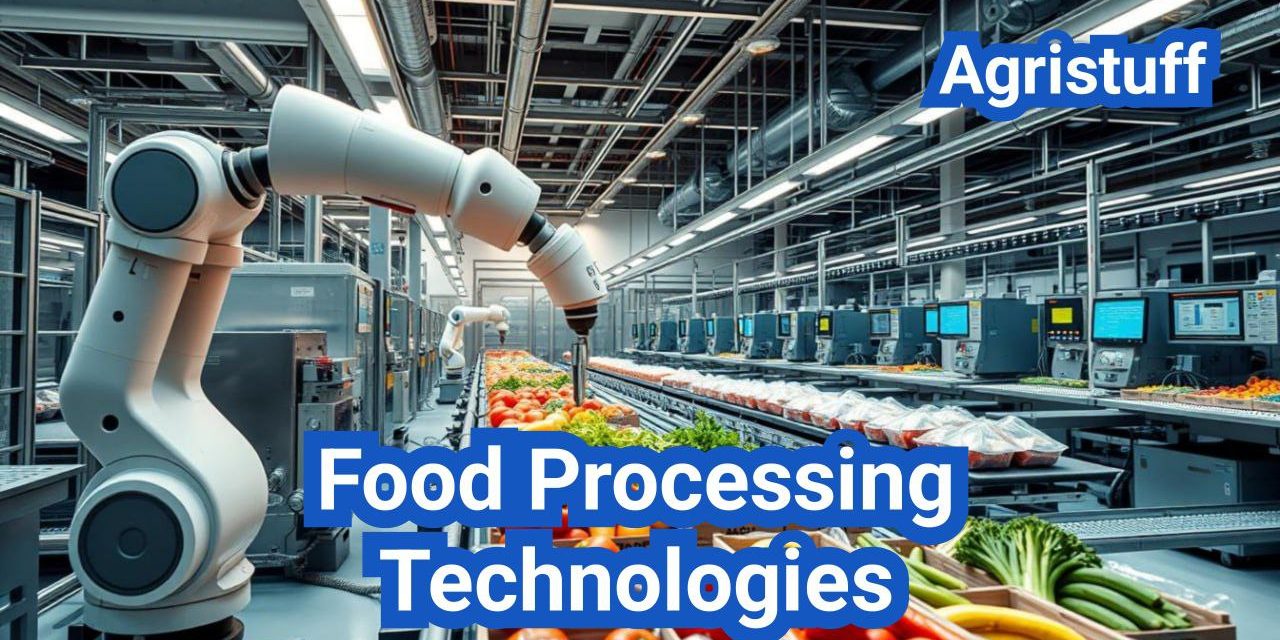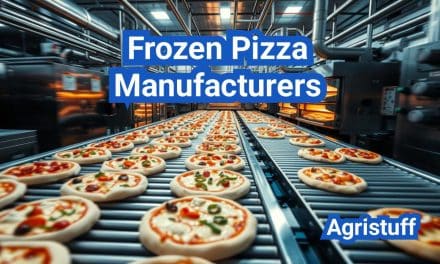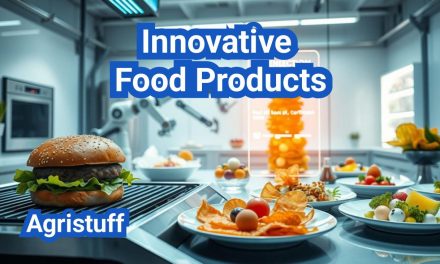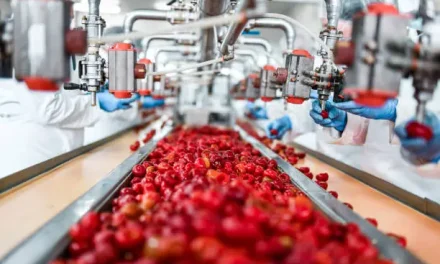The U.S. food industry is undergoing a significant transformation with the adoption of advanced technologies. Recent trends indicate that methods such as high pressure processing (HPP), pulsed electric fields (PEF), and ultraviolet (UV) light processing are gaining popularity.
These emerging food processing technologies offer numerous benefits, including improved safety and quality. By leveraging these latest methods, U.S. producers can enhance their products while meeting the growing demand for safe and healthy food.
Key Takeaways
- Advanced technologies are transforming the U.S. food industry.
- Methods like HPP, PEF, and UV light processing are becoming increasingly popular.
- These technologies improve food safety and quality.
- U.S. producers are leveraging these methods to meet growing demands.
- The adoption of these technologies is a significant trend in the industry.
The Current Landscape of Food Processing Technologies in the U.S.
The U.S. food processing industry is undergoing a significant transformation driven by technological advancements. This shift is largely in response to changing consumer preferences and the need for more efficient, safe, and sustainable food production methods.
Evolution of Processing Methods in American Food Production
The evolution of food processing technologies in the U.S. has been marked by significant milestones. From traditional canning and freezing to modern techniques like High Pressure Processing (HPP) and Pulsed Electric Fields (PEF), the industry has seen a considerable shift towards more advanced and gentle processing methods that preserve the nutritional and sensory qualities of food products.
Key technological advancements include the development of more efficient thermal processing techniques, the adoption of non-thermal processing methods, and the integration of automation and robotics in processing lines. These advancements have not only improved product quality but also enhanced food safety and reduced production costs.
Key Drivers of Technological Adoption
Several factors are driving the adoption of new food processing technologies in the U.S. Consumer demand for safer, healthier, and more sustainable food products is a primary driver. Additionally, the need to comply with stringent food safety regulations, such as the Food Safety Modernization Act (FSMA), is pushing manufacturers to adopt more advanced processing technologies.
Other key drivers include the need to improve production efficiency, reduce energy consumption, and minimize food waste. The industry is also seeing a growing interest in technologies that can help extend shelf life and improve product traceability.
Fundamental Principles of Modern Food Processing

Advances in food processing technologies have improved product attributes and quality, revolutionizing the food industry. Modern food processing is driven by the need to enhance food safety, nutritional value, and overall quality.
Core Technology Principles and Practice
Modern food processing technologies are grounded in several core principles, including the application of heat, cold, and non-thermal processing methods. Techniques such as High Pressure Processing (HPP) and Pulsed Electric Fields (PEF) processing are becoming increasingly popular due to their ability to preserve the nutritional and sensory qualities of food.
HPP technology involves subjecting food products to extremely high pressures, inactivating harmful bacteria and extending shelf life without compromising product freshness. On the other hand, PEF processing uses electric pulses to disrupt microbial cells, ensuring food safety while maintaining product quality.
Impact on Product Attributes and Quality
The adoption of modern food processing technologies significantly impacts product attributes and quality. For instance, HPP and PEF processing help retain the natural flavor, texture, and nutritional content of food products. These technologies also enable the production of foods with extended shelf life, reduced preservative content, and improved overall quality.
Furthermore, modern food processing technologies allow for greater flexibility in product development, enabling manufacturers to create a wide range of products tailored to consumer preferences. The use of advanced processing techniques also facilitates compliance with food safety regulations, ensuring that products meet stringent quality standards.
Thermal Processing Technologies in U.S. Food Production
Thermal processing technologies play a crucial role in ensuring the safety and quality of food products in the U.S. food production industry. These technologies involve the application of heat to achieve microbial inactivation and product sterilization, which are critical for extending shelf life and ensuring consumer safety.
Traditional Heat Treatment Methods
Traditional heat treatment methods have been the backbone of food processing for decades. Techniques such as pasteurization and sterilization are widely used across various food products, including dairy, meat, and canned goods. These methods involve heating the food to a specific temperature for a defined period, followed by cooling, to eliminate harmful bacteria and extend shelf life.
The effectiveness of traditional heat treatment methods lies in their ability to balance microbial safety with product quality. However, these methods can sometimes result in the loss of nutritional value and alteration of the food’s sensory characteristics.
Radio Frequency Food Heating Applications
Radio frequency (RF) heating is an emerging technology that offers a more uniform and efficient heating method compared to traditional techniques. RF heating uses electromagnetic waves to generate heat within the food product, reducing processing time and improving product quality.
This technology is particularly beneficial for heating large volumes of food products, such as meat and poultry, without causing significant quality degradation. RF heating is also being explored for its potential in reducing microbial contamination in various food products.
Aseptic Processing and UHT Technology Implementation
Aseptic processing and Ultra-High Temperature (UHT) technology are advanced thermal processing methods that have revolutionized the food industry. Aseptic processing involves sterilizing the food product outside the packaging, followed by filling into pre-sterilized containers in a sterile environment. UHT technology involves heating the product to a very high temperature for a short period, followed by rapid cooling, to achieve sterilization.
These technologies are particularly useful for liquid and semi-liquid products, such as milk and juice. They offer the advantage of longer shelf life without refrigeration, making them ideal for distribution in various markets.
| Technology | Application | Benefits |
|---|---|---|
| Traditional Heat Treatment | Pasteurization, Sterilization | Microbial safety, Extended shelf life |
| Radio Frequency Heating | Meat, Poultry, Processed Foods | Uniform heating, Reduced processing time |
| Aseptic Processing & UHT | Liquid, Semi-liquid Products | Long shelf life, No refrigeration needed |
High Pressure Processing (HPP): Implementation Guide
With its ability to inactivate microorganisms without heat, High Pressure Processing (HPP) is transforming food safety. HPP is a non-thermal processing technology that involves the application of high pressure to extend shelf life and ensure food safety.
How HPP Technology Works
HPP technology works by subjecting packaged food products to extremely high pressures, typically between 400 and 600 MPa, for a specified duration. This process inactivates harmful bacteria, viruses, and other pathogens, thereby extending the product’s shelf life without compromising its nutritional value or taste.
The HPP process involves several key steps:
- Packaging: Food products are packaged in flexible containers or bags that can withstand high pressure.
- Loading: The packaged products are loaded into the HPP vessel.
- Pressurization: The vessel is closed, and high pressure is applied.
- Holding: The pressure is maintained for a specific time.
- Depressurization: The pressure is released, and the products are removed.
High Pressure Processing Machine Selection
Selecting the right HPP machine is crucial for effective implementation. Factors to consider include:
- Vessel size: Determines the batch size and production capacity.
- Pressure level: Should match the requirements of the products being processed.
- Automation level: Can impact labor costs and process consistency.
- Material compatibility: Ensures the machine can handle the product and packaging materials.
When choosing an HPP machine, manufacturers should also consider the machine’s energy efficiency, maintenance requirements, and compatibility with existing production lines.
| Machine Feature | Description | Importance Level |
|---|---|---|
| Vessel Size | Determines batch size and production capacity | High |
| Pressure Level | Should match product processing requirements | High |
| Automation Level | Impacts labor costs and process consistency | Medium |
| Material Compatibility | Ensures compatibility with product and packaging | High |
Product Development for HPP Applications
Developing products for HPP applications requires careful consideration of packaging, product formulation, and processing parameters. Products that are well-suited for HPP include:
- Ready-to-eat meals
- Juices and beverages
- Dips and spreads
- Meat and seafood products
Manufacturers should also consider the impact of HPP on product texture, flavor, and nutritional content.
By understanding how HPP technology works, selecting the appropriate HPP machine, and developing products suitable for HPP, manufacturers can effectively implement this technology to enhance food safety and extend shelf life.
Pulsed Electric Fields (PEF) Processing Methods
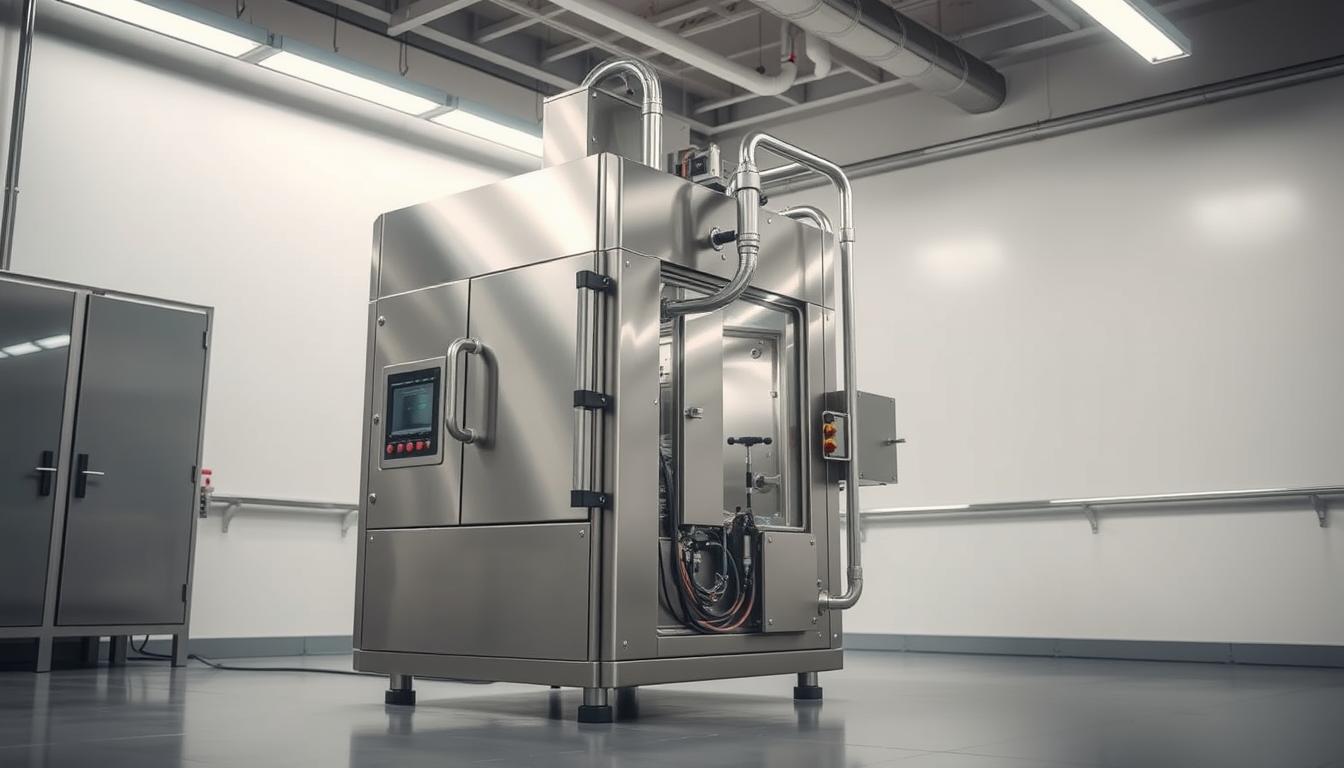
Pulsed Electric Fields (PEF) technology is revolutionizing the food processing industry with its non-thermal approach to microbial inactivation. This method involves applying short bursts of high voltage electric pulses to food products, effectively reducing microbial load without significantly altering the food’s temperature, texture, or nutritional content.
PEF Technology Principles and Equipment
The principle behind PEF technology lies in its ability to create pores in microbial cell membranes through electroporation, leading to cell lysis and death. The equipment used for PEF processing typically consists of a high voltage pulse generator, a treatment chamber where the food is subjected to the electric fields, and a control system to monitor and adjust the processing parameters.
Key Components of PEF Equipment:
- High voltage pulse generator
- Treatment chamber
- Control and monitoring system
Setting Up PEF Systems in Production Facilities
Implementing PEF technology in production facilities requires careful planning and integration with existing processing lines. Factors such as the type of product being processed, desired throughput, and energy requirements need to be considered when setting up a PEF system.
| Consideration | Description |
|---|---|
| Product Type | Liquid or semi-liquid products are more suitable for PEF processing. |
| Throughput | System capacity should match production volume requirements. |
| Energy Requirements | Energy consumption varies based on pulse intensity and frequency. |
Product Categories Best Suited for PEF
PEF technology is particularly beneficial for processing liquid and semi-liquid foods, such as juices, smoothies, and liquid eggs, where maintaining nutritional quality and flavor is crucial.
By understanding the principles, equipment, and application of PEF technology, food producers can leverage this innovative method to enhance product safety and quality, meeting consumer demands for fresher, more nutritious food products.
Ultraviolet and Light-Based Food Processing Techniques
Ultraviolet (UV) light processing has emerged as a significant non-thermal technology in the food industry, offering a promising solution for surface decontamination and microbial inactivation. This method is particularly valuable for its ability to preserve the nutritional and sensory qualities of food products.
Implementation Steps for UV Technology
The successful implementation of UV technology in food processing involves several key steps. First, a thorough assessment of the processing environment is necessary to determine the optimal placement and number of UV lamps required. The type of food product, its surface characteristics, and the desired level of microbial reduction are critical factors in this assessment.
Next, the selection of appropriate UV equipment is crucial. This includes choosing lamps with the correct wavelength and intensity for the specific application. For instance, UV-C light, typically at a wavelength of 254 nm, is commonly used for its germicidal properties.
Finally, validation of the UV treatment process is essential to ensure its effectiveness. This involves microbiological testing to confirm the desired level of microbial reduction and verifying that the treatment does not adversely affect the food’s quality attributes.
Surface Decontamination Applications
UV light processing is particularly effective for surface decontamination of various food products, including fruits, vegetables, meats, and poultry. It can be applied in different stages of food processing, from raw material preparation to final product packaging.
One of the significant advantages of UV surface decontamination is its ability to reduce microbial contamination without the use of chemicals or water. This makes it an attractive option for processors looking to minimize their environmental footprint and comply with increasingly stringent regulations on water usage and wastewater management.
Key benefits of UV surface decontamination include:
- Reduced microbial contamination
- No chemical residues
- Water conservation
- Preservation of food quality
Regulatory Considerations for U.S. Producers
U.S. food producers must comply with relevant regulations when implementing UV light processing. The FDA regulates the use of UV light for food processing under the Food Safety Modernization Act (FSMA).
Processors must validate their UV treatment processes to ensure they meet the required microbial reduction standards. This involves working with regulatory experts and conducting thorough validation studies.
Additionally, producers should stay informed about any updates to regulations or guidelines related to UV processing. This may involve participating in industry associations and collaborating with regulatory bodies to ensure compliance and facilitate the adoption of UV technology.
Cold Plasma Decontamination: Adoption Strategies

As the food industry continues to evolve, cold plasma decontamination is gaining attention for its potential to improve product safety without compromising quality. Cold plasma is a non-thermal technology used for microbial inactivation and surface decontamination, making it an attractive option for food processors.
Cold Plasma Generation Systems
Cold plasma generation involves creating a plasma state at room temperature, which is then used for decontamination purposes. The systems typically consist of a power source, a plasma generator, and a treatment chamber. The effectiveness of these systems depends on factors such as the type of gas used, the power input, and the treatment duration.
Key components of cold plasma generation systems include:
- Power source: Provides the necessary energy for plasma generation.
- Plasma generator: Converts the input energy into plasma.
- Treatment chamber: Where the food products are exposed to the plasma.
Integration into Processing Lines
Integrating cold plasma decontamination into existing processing lines requires careful planning. It involves assessing the current production workflow, identifying suitable integration points, and ensuring compatibility with other processing equipment.
The following table outlines the steps involved in integrating cold plasma technology into food processing lines:
| Step | Description |
|---|---|
| 1. Assessment | Evaluate the current production line and identify potential integration points. |
| 2. Compatibility Check | Ensure that the cold plasma system is compatible with existing equipment. |
| 3. Installation | Install the cold plasma generation system at the identified integration point. |
| 4. Testing | Conduct thorough testing to ensure the system works effectively with the existing production line. |
Effectiveness Validation Protocols
Validating the effectiveness of cold plasma decontamination is crucial for its adoption in the food industry. This involves conducting microbial inactivation studies, assessing the impact on product quality, and ensuring compliance with regulatory requirements.
Key aspects of effectiveness validation include:
- Microbial inactivation studies: To determine the efficacy of cold plasma in reducing microbial loads.
- Product quality assessment: To ensure that cold plasma treatment does not adversely affect the product’s sensory or nutritional qualities.
- Regulatory compliance: Ensuring that the cold plasma decontamination process meets relevant food safety regulations.
Advanced Packaging Technologies for Extended Shelf Life

Advanced packaging technologies, including modified atmosphere packaging and intelligent packaging, are transforming the food industry’s approach to shelf life management. These technologies play a crucial role in maintaining product freshness, reducing waste, and enhancing overall quality.
Modified Atmosphere Packaging (MAP) Implementation
Modified Atmosphere Packaging (MAP) involves replacing the air in a package with a gas mixture to extend shelf life. This technology is particularly effective for products such as fresh meat, poultry, and bakery goods.
The implementation of MAP requires careful consideration of several factors, including the type of product, packaging material, and gas composition. A well-designed MAP system can significantly reduce spoilage and maintain product quality.
| Product Category | Recommended Gas Mixture | Shelf Life Extension |
|---|---|---|
| Fresh Meat | 60-80% O2, 20-40% CO2 | Up to 14 days |
| Bakery Goods | 100% CO2 or N2 | Up to 30 days |
| Poultry | 30-50% CO2, balance N2 | Up to 21 days |
Intelligent and Active Packaging Systems
Intelligent packaging systems incorporate technologies that monitor the condition of the packaged product, providing real-time information on factors such as temperature, humidity, and freshness. Active packaging, on the other hand, involves packaging materials that interact with the product or its environment to enhance shelf life.
Examples of intelligent packaging include time-temperature indicators and freshness sensors. Active packaging technologies include oxygen scavengers and antimicrobial packaging materials.
Packaging Integration with Processing Technologies
The integration of packaging technologies with food processing methods is crucial for maximizing shelf life and product quality. This includes the use of aseptic packaging, vacuum packaging, and packaging under modified atmospheres.
By combining advanced packaging technologies with processing techniques such as High Pressure Processing (HPP) or Pulsed Electric Fields (PEF), food manufacturers can achieve significant improvements in product safety and quality.
Membrane Filtration Technologies in U.S. Dairy Processing

Membrane filtration has revolutionized the dairy processing industry in the United States by enhancing product quality and yield. This technology has become crucial for dairy processors looking to improve efficiency and meet the growing demand for high-quality dairy products.
Filtration System Design and Selection
The design and selection of membrane filtration systems are critical for effective dairy processing. Key considerations include:
- Membrane Material: Choosing the right membrane material is essential for ensuring compatibility with dairy products and achieving the desired filtration efficiency.
- System Configuration: The configuration of the filtration system can significantly impact its performance and operational costs.
- Scalability: Dairy processors must consider the scalability of the filtration system to accommodate future production needs.
Applications in Milk and Whey Processing
Membrane filtration is widely used in the processing of milk and whey, offering several benefits:
- Improved Product Quality: Membrane filtration helps remove impurities and achieve the desired product consistency.
- Enhanced Yield: By optimizing the filtration process, dairy processors can increase product yield and reduce waste.
- Energy Efficiency: Modern membrane filtration systems are designed to be energy-efficient, reducing operational costs.
Operational Parameters for Optimal Results
To achieve optimal results with membrane filtration, dairy processors must carefully control operational parameters, including:
- Pressure and Flow Rate: Adjusting pressure and flow rate can significantly impact filtration efficiency and product quality.
- Temperature Control: Maintaining the optimal temperature is crucial for ensuring the stability and quality of dairy products.
- Cleaning and Maintenance: Regular cleaning and maintenance of membrane filtration systems are essential for preventing contamination and ensuring consistent performance.
Implementing Freeze-Drying (Lyophilization) Methods

In the realm of food processing, freeze-drying stands out as a sophisticated method for extending shelf life. Freeze-drying, or lyophilization, is a preservation technology that removes water from products, thereby improving their shelf life and quality.
Freeze-Drying Process Setup
Setting up a freeze-drying process involves several critical steps. First, the product must be frozen to a temperature that makes its water content become ice. This step is crucial as it affects the subsequent drying process.
The frozen product is then subjected to a vacuum environment, where the ice sublimates (turns directly into vapor) without going through the liquid phase. This process is known as primary drying.
After primary drying, a secondary drying phase, or desorption, may be applied to remove any remaining moisture. This step ensures that the product reaches the desired level of dryness.
Equipment Selection and Scaling
Choosing the right freeze-drying equipment is vital for efficient and effective processing. Factors to consider include the size of the product batch, the type of product being freeze-dried, and the desired level of automation.
Freeze dryers can range from laboratory-scale units to large industrial machines. The selection process involves evaluating the capacity, control systems, and condenser design of the equipment.
| Equipment Type | Capacity | Application |
|---|---|---|
| Laboratory Freeze Dryer | Small batches | Research and development |
| Industrial Freeze Dryer | Large batches | Commercial production |
| Pilot Scale Freeze Dryer | Medium batches | Scaling up production |
Product Preparation and Cycle Development
Product preparation is a critical step in the freeze-drying process. It involves pre-treating the product to enhance its freeze-drying characteristics, such as freezing rate and temperature.
Cycle development refers to optimizing the freeze-drying process for a specific product. This includes determining the optimal freezing temperature, primary and secondary drying times, and vacuum pressure.
Effective cycle development ensures that the final product has the desired texture, flavor, and nutritional content.
By understanding and implementing these aspects of freeze-drying, food producers can leverage this technology to create high-quality products with extended shelf lives.
FSMA Compliance Through Processing Technologies

The Food Safety Modernization Act (FSMA) has revolutionized food safety standards in the U.S. by emphasizing preventive controls. This regulation has significantly impacted how food processing technologies are developed and implemented. Ensuring compliance with FSMA is crucial for food producers to avoid contamination and ensure consumer safety.
Preventive Controls Implementation
Preventive controls are a critical component of FSMA compliance. These controls involve identifying and mitigating potential hazards in the food production process. Implementing preventive controls requires a thorough understanding of the production process, from raw material sourcing to final product packaging.
- Identify potential hazards in the production process.
- Implement controls to mitigate these hazards.
- Monitor and verify the effectiveness of these controls.
Key areas for preventive controls include temperature control, sanitation, and supply chain management. By focusing on these areas, food producers can significantly reduce the risk of contamination.
Food Traceability Systems Under FSMA204
FSMA204 is a critical aspect of FSMA that focuses on food traceability. This regulation requires food producers to maintain detailed records of their production processes, enabling quick tracing of products in case of contamination.
- Maintain detailed records of raw material sourcing.
- Track production processes, including processing and packaging.
- Record distribution details for final products.
Effective traceability systems not only ensure compliance with FSMA204 but also enhance consumer trust and reduce the economic impact of recalls.
Validation Protocols for Food Safety
Validation protocols are essential for ensuring that food safety controls are effective. These protocols involve verifying that the implemented controls are working as intended.
- Develop validation protocols for each control measure.
- Conduct regular testing and verification.
- Maintain records of validation results.
Regular validation ensures that food producers can confidently claim compliance with FSMA regulations, reducing the risk of non-compliance and associated penalties.
Sanitary Design and CGMP in U.S. Food Processing

In the U.S. food processing industry, sanitary design and CGMP play a pivotal role in preventing contamination and ensuring compliance with regulatory requirements. Sanitary design refers to the design of equipment and facilities to minimize the risk of product contamination, while CGMP regulations provide a framework for ensuring the quality and safety of food products.
Equipment Design Selection Criteria
The selection of equipment with sanitary design principles is critical for preventing contamination. Key considerations include the material of construction, ease of cleaning, and the absence of crevices or dead spaces where bacteria can accumulate. Stainless steel is often preferred due to its durability and resistance to corrosion.
When evaluating equipment design, manufacturers should also consider the compatibility of the equipment with their cleaning and sanitation protocols. This includes assessing whether the equipment can withstand the chemicals and temperatures used during the cleaning process.
Facility Layout Optimization
Optimizing the layout of a food processing facility is essential for maintaining sanitary conditions. This involves designing the flow of products, personnel, and materials to minimize cross-contamination risks. Segregation of raw materials from finished products and ensuring that personnel follow proper hygiene practices are crucial aspects of facility layout.
A well-designed facility layout also facilitates efficient cleaning and sanitation by providing adequate space for cleaning equipment and personnel. This can include designated areas for cleaning equipment and the strategic placement of sanitation stations.
Cleaning and Sanitation Program Development
Developing a comprehensive cleaning and sanitation program is vital for maintaining a sanitary environment. This program should include detailed protocols for cleaning and sanitizing equipment and facilities, as well as schedules for regular maintenance and verification of cleaning efficacy.
The program should also incorporate validation protocols to ensure that cleaning and sanitation practices are effective in removing contaminants. Regular training of personnel on cleaning and sanitation procedures is also essential to maintain a high level of compliance.
Conveyor Systems and Automation Integration

The integration of conveyor systems and automation technologies is revolutionizing the food processing industry. As producers seek to enhance efficiency and productivity, the role of advanced conveyor systems becomes increasingly critical.
Modern Conveyor Technology Selection
Selecting the right conveyor technology is crucial for optimizing food processing operations. Modern conveyor systems are designed to handle a variety of products, from raw materials to finished goods, while maintaining hygiene and reducing labor costs.
When choosing a conveyor system, factors such as product type, production volume, and facility layout must be considered. Modular conveyor systems offer flexibility and can be easily reconfigured to accommodate changing production needs.
Integration with Processing Equipment
Seamless integration of conveyor systems with processing equipment is essential for creating a streamlined production line. This integration enables real-time monitoring and control, allowing for immediate adjustments to be made in response to production demands.
“The key to successful automation lies in the harmonious integration of conveyor systems with other processing equipment, creating a cohesive and efficient production environment.”
Industry Expert
Effective integration also involves ensuring compatibility between different components, such as sensors, actuators, and control systems, to prevent operational disruptions.
Automation Implementation Strategies
Implementing automation in conveyor systems requires a strategic approach. Key strategies include assessing current operations, identifying areas for improvement, and selecting appropriate automation technologies.
- Conducting thorough assessments of existing conveyor systems and production workflows.
- Identifying opportunities for automation that can enhance efficiency and reduce costs.
- Implementing scalable automation solutions that can adapt to future production needs.
By adopting these strategies, food producers can maximize the benefits of conveyor system automation, including improved productivity, enhanced product quality, and reduced operational costs.
Nonthermal Food Processing Technologies: A Comparative Guide
As consumers increasingly demand minimally processed foods, nonthermal processing technologies are becoming essential in the food industry. These technologies offer several benefits, including improved food safety and quality, by minimizing the degradation of nutritional and sensory attributes.
Technology Selection Based on Product Requirements
The selection of nonthermal processing technology depends on various product requirements, including the type of food, desired shelf life, and packaging considerations. For instance, High Pressure Processing (HPP) is ideal for products that require high pressure to inactivate pathogens without significantly altering their texture or nutritional content.
In contrast, Pulsed Electric Fields (PEF) is suitable for liquid or pumpable foods, as it helps in preserving the nutritional quality by minimizing thermal damage. Understanding these product requirements is crucial for choosing the most appropriate nonthermal processing technology.
Cost-Benefit Analysis Framework
Conducting a thorough cost-benefit analysis is vital when adopting nonthermal food processing technologies. This involves evaluating the initial investment costs, operational expenses, and potential returns on investment. For example, while HPP equipment can be costly, it offers significant benefits in terms of extended shelf life and improved product safety.
A comprehensive cost-benefit analysis should also consider factors such as energy consumption, maintenance requirements, and the potential for increased production capacity. By weighing these factors, food manufacturers can make informed decisions about the adoption of nonthermal processing technologies.
Implementation Timelines and Resources
The implementation of nonthermal food processing technologies requires careful planning and resource allocation. This includes assessing the need for equipment upgrades, training personnel, and potentially redesigning production lines. The timeline for implementation can vary significantly depending on the complexity of the technology and the scale of production.
Effective project management is crucial to ensure that the implementation process is completed within the projected timeline and budget. This involves coordinating with equipment suppliers, integrating new technologies with existing systems, and monitoring progress to avoid delays.
Emerging Food Processing Technologies Transforming U.S. Production
The U.S. food production industry is on the cusp of a revolution with emerging food processing technologies. These innovations are not only enhancing efficiency and reducing costs but also improving product quality and safety.
Robotics and Smart Manufacturing Implementation
Robotics and smart manufacturing are at the forefront of this transformation. By integrating robotics into production lines, manufacturers can achieve higher precision and consistency. Smart manufacturing technologies, including IoT devices and AI, enable real-time monitoring and predictive maintenance, reducing downtime and increasing overall productivity.
Some key benefits of robotics in food processing include:
- Increased efficiency through automated tasks
- Improved product quality due to precise handling
- Enhanced worker safety by automating hazardous tasks
Predictive Analytics for Quality Control
Predictive analytics is playing a crucial role in maintaining high-quality standards in food production. By analyzing data from various stages of production, predictive models can identify potential quality issues before they become major problems. This proactive approach enables manufacturers to take corrective actions, ensuring consistent product quality.
The application of predictive analytics involves:
- Data collection from production lines and supply chains
- Analysis using advanced statistical models and AI algorithms
- Implementation of corrective measures based on predictive insights
Cellular Agriculture Innovations
Cellular agriculture represents a significant shift in how food is produced. By cultivating animal cells in controlled environments, manufacturers can produce meat and other animal products without the need for traditional livestock farming. This technology has the potential to reduce environmental impact, improve animal welfare, and offer consumers alternative protein sources.
Key aspects of cellular agriculture include:
- Cell cultivation techniques
- Bioreactor design and operation
- Scaling up production while maintaining cost-effectiveness
Navigating the Future of Food Processing
The food industry is on the cusp of a technological revolution, driven by innovations in food processing technologies. As U.S. producers continue to adopt new methods and trends, the future of food processing looks promising, with potential improvements in efficiency, safety, and product quality.
Emerging technologies such as high pressure processing, pulsed electric fields, and cold plasma decontamination are transforming the way food is processed. These advancements, coupled with the integration of automation and robotics, will likely shape the future of the industry.
To stay ahead, food manufacturers must remain informed about the latest food industry trends and be willing to invest in new technologies. By doing so, they can capitalize on the opportunities presented by the evolving landscape of food processing, ultimately driving growth and success in the industry.
As the industry continues to evolve, it is clear that the future of food processing will be characterized by increased efficiency, improved product quality, and enhanced safety. By embracing these changes, U.S. producers can maintain their competitive edge and meet the demands of a changing market.
FAQ
What is food processing, and why is it important?
Food processing refers to the transformation of raw ingredients into consumable products through various techniques, including cooking, canning, freezing, and packaging. It is essential for ensuring food safety, extending shelf life, and enhancing product quality.
What are some examples of food processing methods?
Examples of food processing methods include thermal processing (heat treatment), non-thermal processing (high pressure processing, pulsed electric fields), and separation processes (filtration, centrifugation). Other methods include drying, freezing, and packaging technologies.
How do emerging food processing technologies impact the industry?
Emerging technologies, such as robotics, smart manufacturing, and cellular agriculture, are transforming the food industry by improving efficiency, reducing costs, and enhancing product quality. These innovations also enable the development of new products and business models.
What is High Pressure Processing (HPP), and how is it used?
HPP is a non-thermal processing technology that uses high pressure to inactivate microorganisms and extend shelf life. It is commonly used for products like juices, meats, and ready-to-eat meals, offering benefits like improved safety and quality.
What are the benefits of Pulsed Electric Fields (PEF) processing?
PEF processing is a non-thermal technology that uses electrical pulses to inactivate microorganisms and improve product quality. Its benefits include reduced energy consumption, improved texture, and enhanced flavor retention.
How does Ultraviolet (UV) light processing work?
UV light processing is a non-thermal technology that uses ultraviolet light to inactivate microorganisms on surfaces. It is commonly used for surface decontamination, offering benefits like improved safety and reduced chemical usage.
What is Cold Plasma Decontamination, and how is it used?
Cold plasma decontamination is a non-thermal technology that uses ionized gas to inactivate microorganisms. It is used for surface decontamination, offering benefits like improved safety and reduced chemical usage.
How do Advanced Packaging Technologies contribute to food processing?
Advanced packaging technologies, such as Modified Atmosphere Packaging (MAP) and intelligent packaging, contribute to food processing by extending shelf life, improving product quality, and enhancing consumer convenience.
What is the role of Membrane Filtration in dairy processing?
Membrane filtration is used in dairy processing to separate and concentrate milk components, like whey and casein. It offers benefits like improved product quality, reduced waste, and increased efficiency.
How does Freeze-Drying (Lyophilization) work?
Freeze-drying is a preservation technology that removes water from products by freezing and vacuum drying. It offers benefits like improved product quality, extended shelf life, and reduced weight.
What is FSMA, and how does it relate to food processing?
FSMA (Food Safety Modernization Act) is a regulation that aims to improve food safety in the U.S. It requires food processors to implement preventive controls, monitor food safety, and maintain records. Compliance with FSMA is essential for ensuring food safety and avoiding regulatory issues.
What is the importance of Sanitary Design and CGMP in food processing?
Sanitary design and CGMP (Current Good Manufacturing Practice) are essential for ensuring food safety and quality. They involve designing and maintaining facilities, equipment, and processes to prevent contamination and ensure compliance with regulations.
How do Conveyor Systems and Automation contribute to food processing?
Conveyor systems and automation improve food processing by increasing efficiency, reducing labor costs, and enhancing product quality. They enable the integration of processing equipment and facilitate the implementation of Industry 4.0 technologies.
What are Nonthermal Food Processing Technologies, and how are they used?
Nonthermal food processing technologies, like HPP and PEF, are used to inactivate microorganisms and improve product quality without heat. They offer benefits like improved safety, reduced energy consumption, and enhanced product texture.
What are some Emerging Food Processing Technologies that are transforming the industry?
Emerging technologies, such as robotics, smart manufacturing, and cellular agriculture, are transforming the food industry by improving efficiency, reducing costs, and enhancing product quality. They enable the development of new products and business models, and are expected to shape the future of food processing.
Conclusion of: Food Processing Technologies
What “food processing technologies” mean for U.S. producers
In the United States, food processing technologies are the science-driven methods, equipment, and controls that transform raw ingredients into safe, high-quality, and shelf-stable foods. From thermal and nonthermal kill-steps to smart packaging and digital traceability, modern systems are built around risk-based controls, validation, and continuous monitoring. These technologies operate within clear U.S. rules that emphasize prevention and verification across the entire plant. FDA 21 CFR Part 117 (CGMP & Preventive Controls)
Why food processing technologies matter for safety and quality
Modern food processing technologies help reduce the public-health burden of foodborne disease while preserving nutrition and sensory quality. Each year in the U.S., CDC estimates about 48 million illnesses, 128,000 hospitalizations, and 3,000 deaths from foodborne pathogens—numbers that underscore why validated processes and rigorous preventive controls are non-negotiable. CDC: About Food Safety
The regulatory foundation behind food processing technologies
All U.S. food processing technologies must align with the Food Safety Modernization Act (FSMA), which requires hazard analysis, risk-based preventive controls, and documented verification under Part 117. This “preventive first” approach integrates supplier controls, sanitation, allergen management, and environmental monitoring into day-to-day operations. FDA: FSMA Preventive Controls Rule
Shelf-stable thermal food processing technologies: LACF (canning & retorting)
For shelf-stable foods, food processing technologies include commercial sterilization of low-acid foods (LACF) in hermetically sealed containers, governed by 21 CFR 113. These processes target spores like C. botulinum and require scheduled processes filed with FDA, operator training, and meticulous recordkeeping. 21 CFR Part 113 (LACF)
Acidified foods as part of food processing technologies
When processors use acidification as a control, food processing technologies fall under 21 CFR 114 for acidified foods. The rule requires achieving and maintaining a finished equilibrium pH of 4.6 or below according to a scheduled process and verifying that pH target consistently. 21 CFR Part 114 (Acidified Foods)
Aseptic/UHT: continuous thermal food processing technologies
Aseptic and UHT are continuous food processing technologies that sterilize product and packaging separately, then fill under sterile conditions—popular for shelf-stable beverages and dairy alternatives. FDA guidance clarifies how aseptic systems interface with LACF/acidified rules and filing requirements. FDA Guidance: LACF & FSMA Interface
High-Pressure Processing (HPP) as clean-label food processing technologies
HPP is a nonthermal food processing technology that inactivates pathogens at ambient or chilled temperatures using isostatic pressure (e.g., ~600 MPa). It’s widely used for RTE meats, dips, juices, and seafood to control Listeria and other hazards without heat-driven flavor changes. USDA FSIS guidance discusses post-lethality treatments and validation expectations for RTE meat and poultry. FSIS: Listeria Control in RTE Meats
Pulsed Electric Fields (PEF) among emerging food processing technologies
PEF applies short, high-voltage pulses to disrupt microbial cell membranes—an emerging food processing technology explored for juices, liquid eggs, and pumpable foods. Industry and academic groups track adoption potential, process validation, and quality retention relative to heat. IFT: Emerging Technologies for Processing & Packaging
UV-C and light-based food processing technologies
Ultraviolet irradiation (UV-C) is a nonthermal food processing technology used for surfaces, water, and some clear beverages. U.S. rules explicitly address UV for foods (e.g., juice) and processing environments; systems are engineered to ensure dose, exposure time, and optical path deliver intended lethality. 21 CFR 179.39 (Ultraviolet Radiation)
Cold plasma as next-gen food processing technologies
Cold plasma—ionized gas at near-ambient temperature—offers a promising food processing technology for surface decontamination of produce, packaging, and equipment. U.S. research programs continue to study efficacy, quality impacts, and scale-up for commercial lines. USDA ARS: Nonthermal Intervention Technologies
Ozone as a sanitizing aid within food processing technologies
Ozone is an approved antimicrobial aid in U.S. food processing technologies and can be applied in water or gas phase for washed produce, equipment, and CIP adjuncts. Its strong oxidizing power demands precise controls and ventilation but can reduce reliance on other chemicals. 21 CFR 173.368 (Ozone)
Microwave & radio-frequency (RF) heating as food processing technologies
Electromagnetic food processing technologies like microwave and RF enable rapid volumetric heating and have shown promise in pasteurizing shell eggs, stabilizing moist foods, and reducing process times. Peer-reviewed work documents kinetics, equipment design, and quality outcomes in model foods. Review: RF Heating in Food Processing
Membrane filtration & ESL milk in food processing technologies
Membrane-based food processing technologies (micro-, ultra-, nano-filtration; RO) separate microbes and macromolecules to standardize dairy, clarify juices, and extend shelf life when combined with heat or aseptic steps. These processes operate under the Grade “A” Pasteurized Milk Ordinance framework in dairy plants. FDA: Pasteurized Milk Ordinance (PMO)
Risk management when applying membrane food processing technologies
When deploying membrane-based food processing technologies, processors must validate controls against sporeformers and heat-tolerant microbes. Recent research has highlighted spoilage organisms that can survive downstream pasteurization if pre-separation steps are not designed and verified carefully. Cornell CALS: Microfiltration & Spoilage Risk
Freeze-drying (lyophilization) as part of food processing technologies
Freeze-drying is a low-temperature food processing technology that removes water by sublimation to produce very light, shelf-stable foods with excellent quality retention—used for fruits, coffee, meals, and high-value ingredients. Safety still hinges on upstream kill-steps and hygienic handling. FSIS: Shelf-Stable Food (Freeze-Drying)
Modified-atmosphere packaging (MAP) among packaging-focused food processing technologies
Packaging-centric food processing technologies like MAP adjust gas composition to slow respiration and spoilage in fresh-cut produce and meats. MAP is a “hurdle” that complements proper refrigeration and prior lethality steps rather than replacing them. UC Davis: Modified Atmosphere Packaging
Active & intelligent packaging as enabling food processing technologies
Active/“smart” packaging extends food processing technologies beyond the line by incorporating oxygen scavengers, antimicrobial surfaces, or time-temperature indicators (TTIs) that signal mishandling. U.S. research programs continue to explore printable sensors and freshness indicators compatible with regulatory requirements. USDA ARS: Intelligent Packaging Research
Digital, sensors, AI & traceability now orbit all food processing technologies
Digitally enabled food processing technologies link sensors, vision systems, and predictive models to control hazards and verify processes in real time. FDA’s “New Era of Smarter Food Safety” pushes tech-enabled traceability (including FSMA 204), data interoperability, and responsible AI to strengthen prevention. FDA: New Era of Smarter Food Safety
Process validation and documentation across food processing technologies
Regardless of the platform, validated critical limits, scientifically sound monitoring, and thorough records are the backbone of U.S. food processing technologies. Filing scheduled processes for LACF/acidified foods, documenting thermal or nonthermal lethality, and maintaining verification data prove that products meet safety objectives. FDA: Register & File LACF/AF Processes
Choosing the right toolbox of food processing technologies
The best U.S. plants integrate multiple food processing technologies—for example, HPP plus MAP, or UHT plus aseptic packaging—so each hurdle reinforces the others with minimal impact on flavor and nutrition. Trade-offs among safety margin, cost, sustainability, and label goals guide the final process design. IFT: Technology Trade-offs & Trends
Final thought
As U.S. consumer expectations rise and supply chains get smarter, food processing technologies are converging around prevention, digitization, and multipronged hurdles that protect safety and quality without sacrificing taste. The winners will be processors who validate rigorously, monitor continuously, and upgrade thoughtfully as science and regulations evolve. FDA: FSMA Rules & Guidance (All)
Sources & References
- 21 CFR Part 117 – CGMP & Preventive Controls
- FSMA Final Rule: Preventive Controls for Human Food
- 21 CFR Part 113 – Low-Acid Canned Foods
- 21 CFR Part 114 – Acidified Foods
- FDA Guidance: LACF & FSMA Interface
- FSIS: Control of Listeria monocytogenes in RTE Meat & Poultry
- 21 CFR 179.39 – Ultraviolet Radiation
- USDA ARS: Nonthermal Intervention Technologies (overview)
- 21 CFR 173.368 – Ozone
- Review: Radio-Frequency Heating in the Food Industry
- FDA: Pasteurized Milk Ordinance (PMO) Overview
- Cornell CALS: Microfiltration & Pasteurization-Resistant Microbe
- FSIS: Shelf-Stable Food (Freeze-Drying)
- FDA: New Era of Smarter Food Safety (Blueprint)
- CDC: At-a-Glance — Food Safety
- FDA: LACF/Acidified Foods — Registration & Filing

